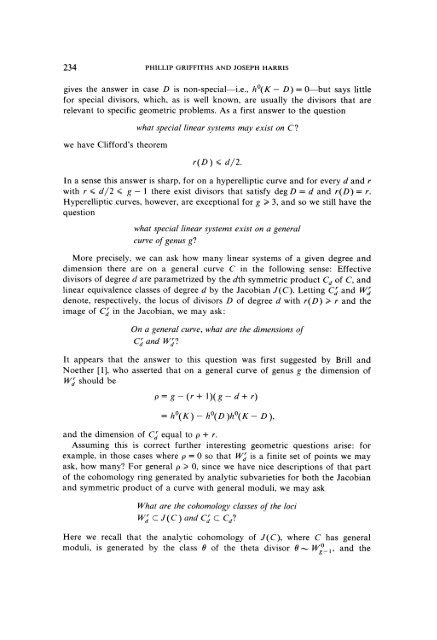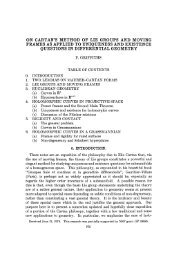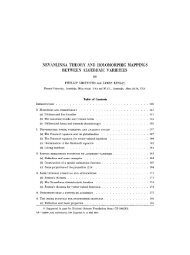View PDF - Project Euclid
View PDF - Project Euclid
View PDF - Project Euclid
Create successful ePaper yourself
Turn your PDF publications into a flip-book with our unique Google optimized e-Paper software.
234 PHILLIP GRIFFITHS AND JOSEPH HARRIS<br />
gives the answer in case D is non-special--i.e., h(K- D)= 0--but says little<br />
for special divisors, which, as is well known, are usually the divisors that are<br />
relevant to specific geometric problems. As a first answer to the question<br />
we have Clifford’s theorem<br />
what special linear svstems may exist on C?<br />
r(D ) < d/2.<br />
In a sense this answer is sharp, for on a hyperelliptic curve and for every d and r<br />
with r < d/2 < g- there exist divisors that satisfy deg D d and r(D)= r.<br />
Hyperelliptic .curves, however, are exceptional for g > 3, and so we still have the<br />
question<br />
what special linear systems exist on a general<br />
curve of genus g?<br />
More precisely, we can ask how many linear systems of a given degree and<br />
dimension there are on a general curve C in the following sense" Effective<br />
divisors of degree d are parametrized by the dth symmetric product C a of C, and<br />
linear equivalence classes of degree d by the Jacobian J(C). Letting C and W<br />
denote, respectively, the locus of divisors D of degree d with r(D) > r and the<br />
image of C in the Jacobian, we may ask"<br />
On a general curve, what are the dimensions of<br />
C, and IA’zr9<br />
It appears that the answer to this question was first suggested by Brill and<br />
Noether [1], who asserted that on a general curve of genus g the dimension of<br />
W, should be<br />
p=g-(r+ 1)(g-d+r)<br />
h(K)- h(D )h(K D ),<br />
and the dimension of C equal to p + r.<br />
Assuming this is correct further interesting geometric questions arise" for<br />
example, in those cases where p 0 so that W is a finite set of points we may<br />
ask, how many? For general p > O, since we have nice descriptions of that part<br />
of the cohomology ring generated by analytic subvarieties for both the Jacobian<br />
and symmetric product of a curve with general moduli, we may ask<br />
What are the cohomolog), classes of the loci<br />
W c J ( C ) and C Cd?<br />
Here we recall that the analytic cohomology of J(C), where C has general<br />
moduli, is generated by the class 0 of the theta divisor 0- Wg_, and the
















